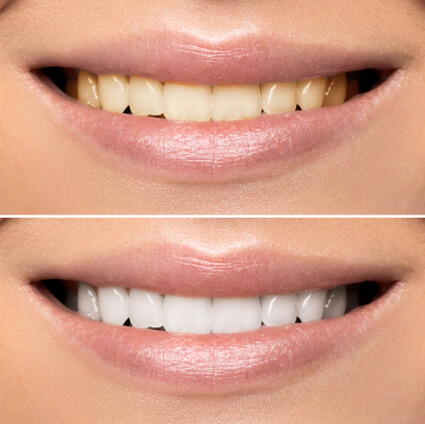Tooth whitening can be a very effective way of lightening the natural colour of your teeth without removing any of the tooth surface. It cannot make a complete colour change, but it may lighten the existing shade.Whitening is among the most popular cosmetic dental procedures because it can greatly improve how your teeth look. There are a number of reasons why you might get your teeth whitened. Everyone is different; and just as our hair and skin colour vary, so do our teeth. Very few people have brilliant-white teeth, and our teeth can also become more discoloured as we get older.Your teeth can also be stained on the surface by food and drinks such as tea, coffee, red wine and blackcurrant. Smoking can also stain teeth.‘Calculus' or tartar can also affect the colour of your teeth. Some people may have staining under the surface, which can be caused by certain antibiotics or by tiny cracks in the teeth which take up stains.
Your teeth have pores just like your skin or a sponge. Anything you put in your mouth that has color will absorb into those pores. Wine, coffee, dark berries, and smoking are extremely active in staining teeth. Over time, the natural color of your teeth becomes darker due to these stains. These stains will never go away unless you actively remove them. Properly formulated teeth whitening gel works by absorbing into your teeth and gently pushing stains out through the pores.For everyone, teeth yellowing is a normal part of aging. Our hair turns gray and our teeth turn yellow. It’s the inner part of the tooth called dentin—not the outer enamel—that yellows. As teeth repair themselves, the new dentin is darker, and the enamel is getting thinner due to wear, and things like grinding your teeth or acids from foods you eat can thin enamel earlier, making teeth become yellow sooner. The color of dentin reflects through enamel like a prism, making the tooth look yellow.

How Whitening Works
Teeth whitening works in following methods:
- Intrinsic“Intrinsic” refers to whitening the inner part of the tooth, which soaks up hydrogen peroxide gel (also called whitening gel or bleach) and becomes lighter.When the inner part of the tooth is whitened, the color that’s reflected through the outer enamel of your teeth is lighter, making them look whiter and brighter—reflecting out through the enamel like a prism.Contrary to what you might have thought, bleach lightens the inner tissue of the tooth, not the hard, outer enamel.
- ExtrinsicRemoving staining on enamel (the outer part of the tooth) is called extrinsic whitening. The stains left behind by smoking, wine, tea, and coffee are usually easily removed with a polish by your hygienist at a teeth cleaning or with polishing and whitening toothpaste, which we’ll discuss in a bit.